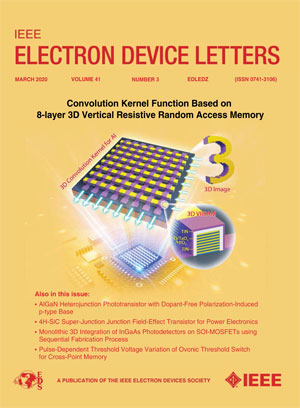原子层蚀刻igzo基无电容DRAM中提高保留率的途径
IF 4.1
2区 工程技术
Q2 ENGINEERING, ELECTRICAL & ELECTRONIC
引用次数: 0
摘要
通过在300mm晶圆厂中采用原子层刻蚀作为InGaZnO (IGZO)薄膜晶体管的有源图图化技术,我们展示了40 nm门长双晶体管零电容(2T0C)动态随机存取存储器(DRAM)器件,其保留时间为bbb200 s,保留时间为95~ {\circ}$ c。我们广泛的2T0C保留测试表明,保留性能可以通过以下方式提高:1)抑制边壁金属残留物作为外部泄漏路径;2)通过优化负保持电压降低亚阈值漏电;3)优化栅极氧化物厚度,避免栅极泄漏增强。此外,利用专用的大栅极面积测试装置,我们成功地确定了写和读晶体管栅极泄漏的驱动机制分别是普尔-弗伦克尔发射和直接隧穿。该器件还可以实现$\gt 10^{{12}}$周期,写入时间$95~^{\circ}$ C,以显着降低的刷新率满足未来2T0C DRAM应用的要求。本文章由计算机程序翻译,如有差异,请以英文原文为准。
Pathways for Retention Boost in Atomic Layer Etched IGZO-Based Capacitorless DRAM
By adopting atomic layer etching as an active patterning technique for InGaZnO (IGZO) based thin-film transistors in a 300-mm fab, we demonstrate 40 nm gate-length two-transistors zero-capacitor (2T0C) dynamic random-access memory (DRAM) devices with retention time >200 s at $95~^{\circ }$ C. Our extensive 2T0C retention tests clarify that retention property can be boosted by 1) suppression of sidewall metal residues to be extrinsic leakage paths; 2) reduction of the subthreshold leakage by negative hold voltage optimization; 3) optimal gate oxide thickness to avoid gate leakage enhancement. Additionally, by utilizing dedicated large gate-area test devices, we successfully identify the driving mechanisms of gate leakage in write and read transistors as Poole-Frenkel emission and direct tunnelling, respectively. The devices can also achieve endurance $\gt 10^{{12}}$ cycles with write time <10> $95~^{\circ }$ C, satisfying the requirements towards future 2T0C DRAM applications with significantly reduced refresh rate.
求助全文
通过发布文献求助,成功后即可免费获取论文全文。
去求助
来源期刊

IEEE Electron Device Letters
工程技术-工程:电子与电气
CiteScore
8.20
自引率
10.20%
发文量
551
审稿时长
1.4 months
期刊介绍:
IEEE Electron Device Letters publishes original and significant contributions relating to the theory, modeling, design, performance and reliability of electron and ion integrated circuit devices and interconnects, involving insulators, metals, organic materials, micro-plasmas, semiconductors, quantum-effect structures, vacuum devices, and emerging materials with applications in bioelectronics, biomedical electronics, computation, communications, displays, microelectromechanics, imaging, micro-actuators, nanoelectronics, optoelectronics, photovoltaics, power ICs and micro-sensors.
 求助内容:
求助内容: 应助结果提醒方式:
应助结果提醒方式:


